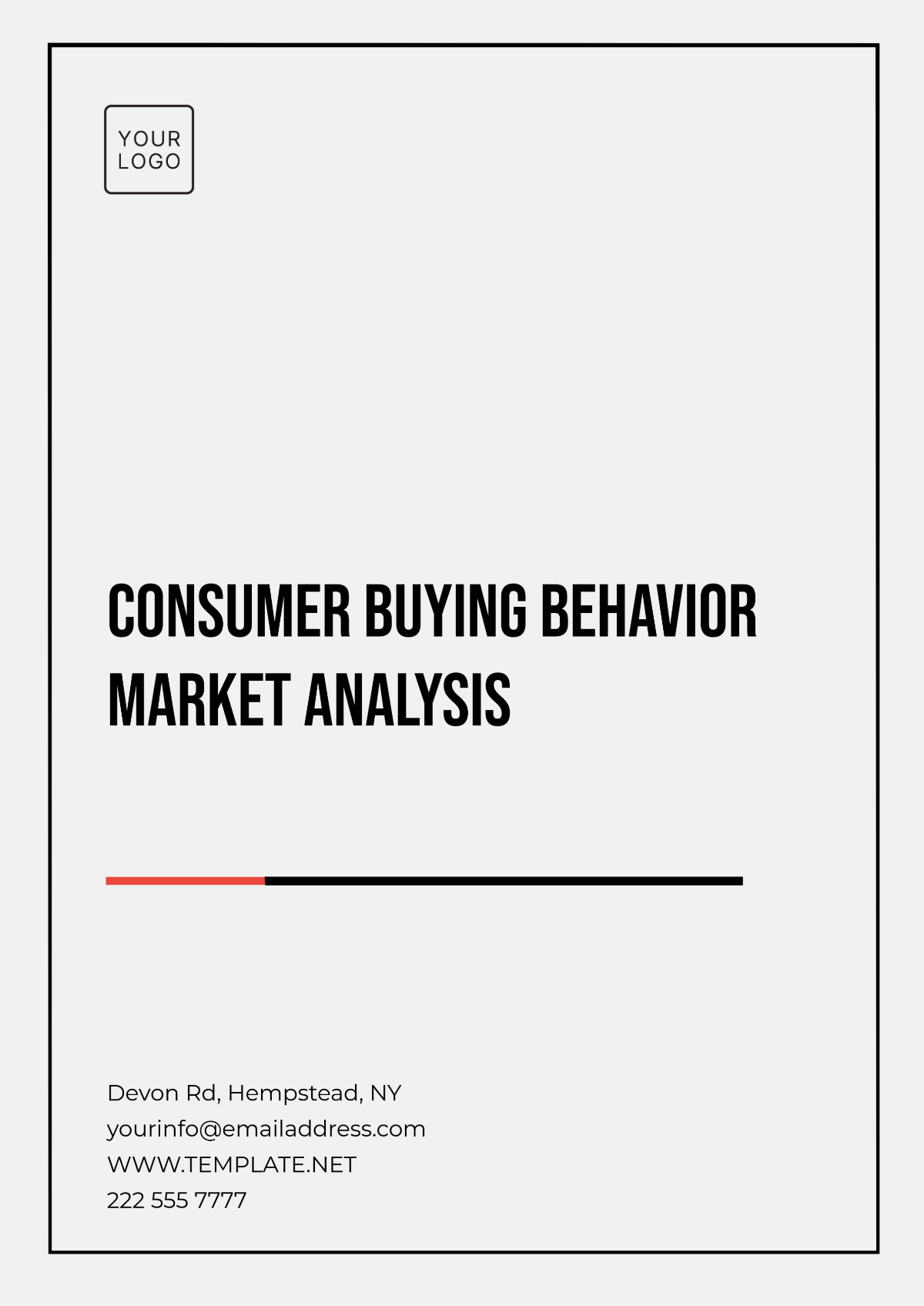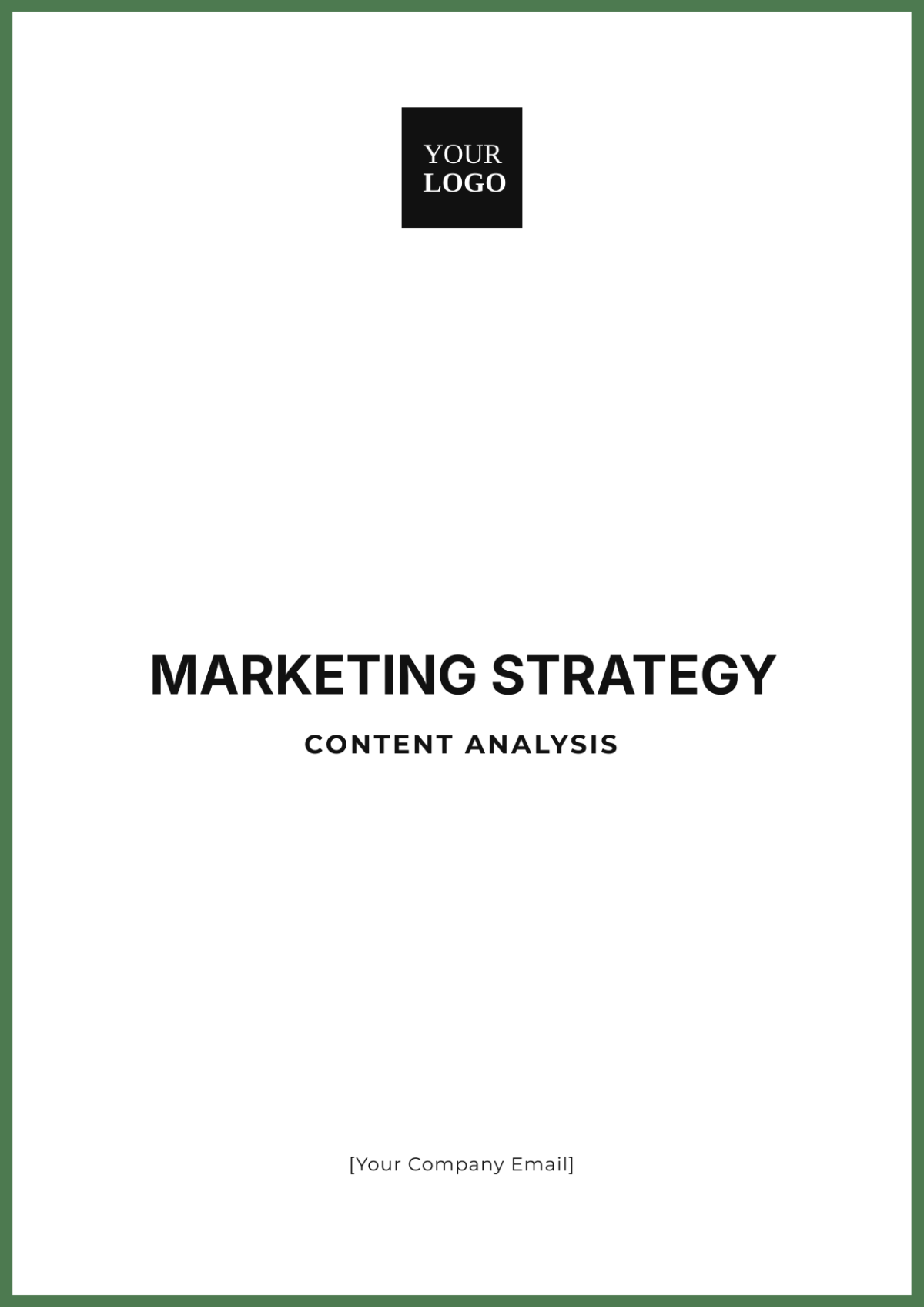Go-to-Market Segmentation Analysis
1. Introduction
In the dynamic landscape of the year 2050, companies are increasingly recognizing the significance of targeted marketing strategies to enhance their competitive advantage. This Go-to-Market (GTM) Segmentation Analysis aims to dissect the multifaceted approaches to market segmentation employed by [Your Company Name]. By strategically categorizing potential customers, businesses can tailor their products and services to meet the specific needs of distinct market segments. This analysis encompasses various segmentation methodologies, evaluates the current market conditions, and outlines actionable strategies for [Your Company Name] to capitalize on its market opportunities.
By gaining a deeper understanding of the nuances within various market segments, [Your Company Name] will be better positioned to optimize its marketing efforts, improve customer engagement, and drive overall business growth. With consumers becoming more discerning and informed, the importance of a well-defined segmentation strategy cannot be overstated.
2. Understanding Go-to-Market Segmentation
2.1 Definition of Go-to-Market Segmentation
GTM segmentation involves dividing a broad target market into subsets of consumers who have common needs, interests, and priorities. By identifying these segments, [Your Company Name] can develop specific marketing strategies that resonate more effectively with each group. This process not only helps in optimizing marketing efforts but also improves customer acquisition rates and enhances overall customer satisfaction. In a world where personalized experiences are increasingly valued, segmentation enables a tailored approach that addresses the unique challenges faced by each consumer group.
2.2 Importance of Segmentation
The importance of segmentation can be summarized as follows:
Enhanced Customer Insights: Understanding customer behaviors, preferences, and pain points allows for more effective communication strategies. By analyzing data on customer interactions, [Your Company Name] can create targeted messaging that speaks directly to the needs and desires of each segment.
Tailored Marketing Strategies: Different segments require unique approaches; segmentation facilitates the development of customized marketing campaigns. By leveraging insights from segmentation, [Your Company Name] can craft messages that resonate with distinct audiences, thereby increasing the likelihood of conversion.
Resource Allocation: Efficient segmentation allows [Your Company Name] to allocate resources effectively, focusing on the most promising market segments. This not only maximizes marketing efficiency but also ensures that investment is directed toward initiatives that yield the highest return.
Competitive Advantage: By meeting the specific needs of different customer groups, [Your Company Name] can establish a stronger market presence. Segmentation enables the company to identify gaps in the market and develop products and services that fulfill unmet consumer needs, thereby positioning itself as a leader in innovation.
2.3 Key Principles of Effective Segmentation
To ensure that segmentation strategies are successful, several key principles must be adhered to:
Measurable: Segments should be quantifiable, allowing for the evaluation of potential market size and profitability. This involves gathering data on various demographic and behavioral attributes to create robust profiles of each segment.
Accessible: The identified segments must be reachable through effective marketing channels. Understanding the preferred communication channels for each segment—be it social media, email, or traditional advertising—is crucial for effective outreach.
Substantial: Segments should be large enough to warrant attention and investment. A segment that is too small may not justify the resources required for targeted marketing efforts.
Differentiable: Each segment must exhibit distinct characteristics that necessitate different marketing strategies. This differentiation is vital for developing unique value propositions that appeal to each specific group.
Actionable: The segmentation must lead to effective strategies that can be implemented by [Your Company Name]. This means that insights gained from segmentation should translate into concrete actions that drive marketing and product development initiatives.
3. Market Segmentation Strategies
3.1 Demographic Segmentation
Demographic segmentation divides the market based on observable characteristics such as age, gender, income level, and education. This approach is particularly beneficial for [Your Company Name], as it allows for the identification of key target audiences.
Age: Different age groups (e.g., Generation Z, Millennials, Gen X, Baby Boomers) exhibit varying preferences and purchasing behaviors. For instance, Generation Z, tends to favor sustainability and technology integration in products and services. Tailoring marketing messages to reflect the values and interests of each age group will enhance engagement and conversions.
Gender: Men and women may have different product preferences and buying behaviors. Marketing strategies should be crafted with these differences in mind, ensuring that both genders feel represented and catered to.
Income Level: Segmenting by income allows [Your Company Name] to offer products that cater to different purchasing power. High-income segments may be interested in premium products, while low-to-middle-income consumers may prioritize affordability and value for money.
Education Level: Educational attainment can influence consumer interests and the effectiveness of marketing messages. For example, highly educated consumers may respond better to in-depth product information and technical specifications.
Table 1: Demographic Segmentation Breakdown
Segment | Key Characteristics | Marketing Strategy |
|---|---|---|
Generation Z | Tech-savvy, socially conscious | Digital marketing, influencer partnerships, eco-friendly products |
Millennials | Experience-driven, value authenticity | Social media campaigns, community engagement, brand storytelling |
Generation X | Brand loyalty, family-oriented | Traditional advertising, loyalty programs, family-oriented content |
Baby Boomers | Value stability, prefer quality | Direct mail, informative content, trust-building strategies |
3.2 Psychographic Segmentation
Psychographic segmentation delves deeper into the lifestyles, values, and personalities of consumers. This approach enables [Your Company Name] to connect with customers on an emotional level, which is increasingly important in today’s market.
Lifestyle: Understanding the lifestyle choices of different segments allows for the development of targeted marketing messages. For example, health-conscious consumers may respond better to products promoting wellness and fitness.
Values: Identifying the core values of consumers, such as sustainability, family, or innovation, can guide product development and marketing narratives. Consumers who value social responsibility may gravitate towards brands that demonstrate ethical practices.
Personality Traits: Different personality types (e.g., introverted vs. extroverted) influence buying behavior and can be considered when crafting marketing campaigns. Tailoring messages to appeal to different personality traits can enhance customer engagement.
Table 2: Psychographic Segmentation Breakdown
Segment | Key Characteristics | Marketing Strategy |
|---|---|---|
Health Enthusiasts | Value fitness and wellness | Content marketing focused on health benefits, partnerships with fitness influencers |
Eco-Conscious Buyers | Prioritize sustainability and ethical brands | Eco-friendly branding, sustainability reports, green product lines |
Trendsetters | Seek the latest trends and innovations | Early access promotions, social media teasers, collaborations with influencers |
Family-Oriented | Focus on family values and experiences | Family-centric advertising, community sponsorships, family-friendly product offerings |
3.3 Geographic Segmentation
Geographic segmentation involves categorizing consumers based on their physical location. This segmentation strategy is particularly relevant for [Your Company Name], as it can help tailor products and marketing efforts to specific regional needs.
Region: Different regions may have distinct cultural norms, preferences, and purchasing habits. For instance, urban consumers may prefer convenience products, while rural consumers may favor traditional items that reflect their lifestyles.
Population Density: Urban, suburban, and rural areas often exhibit different buying behaviors that should be taken into account when designing marketing strategies. Urban dwellers may prioritize fast delivery and accessibility, whereas rural consumers may value product longevity and quality.
Climate: Seasonal changes in weather can influence product demand, such as winter clothing in colder climates versus summer apparel in warmer regions. Understanding local climate can guide inventory and promotional strategies.
Table 3: Geographic Segmentation Breakdown
Segment | Key Characteristics | Marketing Strategy |
|---|---|---|
Urban Consumers | Fast-paced, value convenience | Quick-service products, online shopping options, local partnerships |
Suburban Families | Family-oriented, value space | Family packages, community events, backyard products |
Rural Customers | Price-sensitive, brand loyal | Direct marketing, regional promotions, emphasis on durability |
Climate-specific | Seasonal needs (e.g., winter apparel) | Seasonal marketing campaigns, localized product offerings |
3.4 Behavioral Segmentation
Behavioral segmentation focuses on consumer behaviors related to product usage and decision-making processes. This method helps [Your Company Name] understand how customers interact with products and services, providing insights into marketing strategy development.
Purchase Behavior: Segmenting customers based on their buying habits (e.g., frequent vs. occasional buyers) enables targeted promotions to encourage repeat purchases. Understanding what motivates purchases can lead to effective promotional strategies.
Loyalty Status: Recognizing loyal customers allows [Your Company Name] to create loyalty programs and rewards that incentivize continued patronage. These programs can enhance customer satisfaction and increase the likelihood of referrals.
Usage Rate: Identifying heavy, moderate, and light users helps tailor marketing messages to each group, ensuring relevance. For example, heavy users may appreciate exclusive access to new products or early promotions.
Benefits Sought: Understanding what benefits customers seek from products (e.g., quality, price, convenience) guides product development and positioning. Tailoring messaging to highlight these benefits can lead to increased engagement.
Table 4: Behavioral Segmentation Breakdown
Segment | Key Characteristics | Marketing Strategy |
|---|---|---|
Heavy Users | Frequent buyers, brand advocates | Loyalty rewards, exclusive promotions, early access |
Moderate Users | Occasional buyers, seeking value | Targeted discounts, cross-selling opportunities |
Light Users | Rarely purchase, price-sensitive | Introductory offers, educational content |
Benefit Seekers | Value quality and convenience | Highlighting product benefits, customer testimonials |
4. Current Market Landscape
4.1 Overview of the Market
The market landscape in 2050 is characterized by rapid technological advancements, changing consumer expectations, and heightened competition. Understanding these trends is crucial for [Your Company Name] to navigate the complexities of the current market environment.
Technological Advancements: Emerging technologies, such as artificial intelligence (AI), machine learning, and the Internet of Things (IoT), are transforming how consumers interact with products and brands. [Your Company Name] must leverage these technologies to enhance customer experiences and streamline operations.
Changing Consumer Expectations: Today’s consumers are more informed and demanding than ever before. They seek personalized experiences, ethical practices, and instant gratification. Adapting to these evolving expectations will be vital for [Your Company Name] to maintain relevance.
Increased Competition: As barriers to entry decrease, more players are entering the market, intensifying competition across various sectors. To differentiate itself, [Your Company Name] must employ innovative marketing strategies that highlight its unique value propositions.
4.2 Market Trends
Several key trends are shaping the market in 2050, influencing consumer behavior and purchase decisions:
Sustainability: Consumers are increasingly prioritizing sustainability in their purchasing decisions. Brands that demonstrate environmental responsibility and offer eco-friendly products are likely to gain a competitive edge. [Your Company Name] should consider adopting sustainable practices across its operations to appeal to eco-conscious consumers.
Digital Transformation: The shift towards digital platforms is accelerating, with consumers preferring online shopping and digital engagement over traditional methods. This trend necessitates that [Your Company Name] invests in robust digital marketing strategies and e-commerce capabilities.
Personalization: Customers expect tailored experiences that cater to their unique needs and preferences. Utilizing data analytics to understand customer behavior will enable [Your Company Name] to create personalized marketing campaigns that resonate with different segments.
Health and Wellness: There is a growing focus on health and wellness, particularly among younger consumers. Brands that offer health-conscious products and emphasize well-being in their messaging are likely to attract a loyal customer base. [Your Company Name] should consider expanding its product offerings in this area.
Table 5: Current Market Trends
Trend | Description | Implications for [Your Company Name] |
|---|---|---|
Sustainability | Rising consumer demand for eco-friendly products | Integrate sustainable practices in product development and marketing |
Digital Transformation | Shift towards online shopping and digital engagement | Invest in e-commerce platforms and digital marketing strategies |
Personalization | Demand for tailored customer experiences | Utilize data analytics to create personalized campaigns |
Health and Wellness | Growing interest in health-conscious products | Expand product offerings to cater to health-oriented consumers |
5. Market Segmentation Profiles
5.1 Segment Profiles
This section elaborates on the various segments identified through the previously discussed segmentation strategies. Each profile includes demographic, psychographic, and behavioral insights, offering a comprehensive understanding of the target segments.
Tech-Savvy Millennials
Demographics: Aged 25-40, predominantly urban dwellers, often holding advanced degrees and earning above-average incomes. They represent a significant market segment due to their purchasing power and willingness to invest in innovative products.
Psychographics: They value innovation, sustainability, and social responsibility. This group is often vocal about their beliefs and is likely to support brands that align with their values. They are also highly active on social media, influencing peers through their opinions and reviews.
Buying Behavior: Frequent online shoppers who embrace digital marketing strategies, often influenced by social media trends and peer recommendations. They appreciate loyalty programs and exclusive offers that reward their purchasing behavior.
Health-Conscious Generation Z
Demographics: Aged 18-24, this segment includes diverse backgrounds, with many still in school or early in their careers. Although they typically have limited disposable income, they prioritize spending on health and wellness products.
Psychographics: They prioritize wellness, sustainability, and community engagement. This generation is known for its focus on mental health, social justice, and environmentally friendly practices, often opting for brands that embody these values.
Buying Behavior: Favor brands that align with their values and prioritize products that promote well-being. They are highly influenced by social media, particularly by influencers who share similar lifestyles and values.
Family-Oriented Baby Boomers
Demographics: Aged 56-74, this segment typically includes homeowners and is often located in suburban areas. Their income levels can vary widely, but many have accumulated wealth over their lifetime and are looking for quality products that enhance family experiences.
Psychographics: They value family experiences and quality products, often prioritizing comfort and reliability. This segment tends to be brand loyal and appreciates companies that offer consistent quality and service.
Buying Behavior: Seek value and reliability, often engaging with brands through traditional advertising methods. They are responsive to loyalty programs and direct mail campaigns that highlight special promotions for family-oriented products.
5.2 Market Size Estimation
Estimating the potential market size for each segment is essential for [Your Company Name] to allocate resources effectively and set realistic sales targets. By understanding the market size, the company can prioritize its marketing efforts and align them with overall business objectives.
Table 6: Market Size Estimation for Target Segments
Segment | Estimated Market Size (2050) | Expected Growth Rate (2050-2055) |
|---|---|---|
Tech-Savvy Millennials | [$500 million] | [10%] |
Health-Conscious Generation Z | [$300 million] | [15%] |
Family-Oriented Baby Boomers | [$400 million] | [5%] |
5.3 Strategic Implications of Market Size
Tech-Savvy Millennials: With an estimated market size of [$500 million] and an expected growth rate of [10%], targeting this segment presents a significant opportunity for [Your Company Name]. Investing in innovative products and digital marketing strategies tailored to this group will be essential for capturing their attention and driving sales.
Health-Conscious Generation Z: The projected market size of [$300 million] and a robust growth rate of [15%] signal a rapidly expanding consumer base. Developing products that promote health and wellness, coupled with marketing strategies that resonate with their values, will be critical for engaging this segment effectively.
Family-Oriented Baby Boomers: Although this segment has a smaller estimated market size of [$400 million] and a lower growth rate of [5%], it remains a crucial audience for [Your Company Name]. This demographic's loyalty and focus on quality can yield significant long-term returns through targeted marketing efforts and personalized experiences.
6. Go-to-Market Strategies
6.1 Positioning Strategies
Developing effective positioning strategies is crucial for [Your Company Name] to create a unique identity in the market. Positioning involves defining how the brand is perceived in comparison to competitors. A strong positioning strategy will enable the company to stand out in a crowded marketplace.
Differentiation: Emphasizing unique product features or quality aspects that set [Your Company Name] apart from competitors is essential. For example, if the company offers cutting-edge technology or superior materials, these elements should be highlighted in all marketing communications.
Value-Based Positioning: Highlighting the value proposition by offering competitive pricing or additional benefits that resonate with target segments can create a compelling reason for consumers to choose [Your Company Name]. This could include bundled services, extended warranties, or loyalty rewards that enhance the perceived value of products.
Emotional Positioning: Connecting with consumers on an emotional level through storytelling and brand values that align with customer beliefs can create lasting brand loyalty. Sharing customer success stories or community involvement initiatives can enhance emotional connections with the brand.
Table 7: Positioning Strategies Overview
Strategy | Description | Example for [Your Company Name] |
|---|---|---|
Differentiation | Emphasizing unique features and quality | Highlighting innovative technology in advertising |
Value-Based Positioning | Offering competitive pricing and added benefits | Launching loyalty programs and exclusive deals |
Emotional Positioning | Creating emotional connections through storytelling | Sharing community engagement stories and testimonials |
6.2 Marketing Mix Strategies
The marketing mix, consisting of product, price, place, and promotion, must be tailored for each target segment to optimize market reach and customer engagement. Each element of the marketing mix should be aligned with the preferences and behaviors of the identified segments.
Product Strategy: Tailoring products to meet the specific needs of different segments is essential for driving engagement. For example, eco-friendly packaging can attract health-conscious consumers, while innovative tech features may appeal to tech-savvy millennials.
Pricing Strategy: Implementing dynamic pricing models based on segment-specific willingness to pay will optimize profitability. For instance, offering premium pricing for cutting-edge products while maintaining competitive pricing for budget-conscious consumers can capture a broader market.
Place Strategy: Utilizing various distribution channels that align with consumer preferences will enhance accessibility. For tech-savvy millennials, focusing on online platforms and mobile apps can increase engagement, while family-oriented baby boomers may prefer traditional retail outlets with personalized service.
Promotion Strategy: Crafting targeted promotional campaigns that resonate with each segment will drive engagement and conversion. Digital marketing strategies, such as social media advertising for younger consumers and direct mail for older demographics, can be highly effective.
Table 8: Marketing Mix Strategies Overview
Element | Strategy | Target Segment |
|---|---|---|
Product | Tailored offerings for each segment | Eco-friendly products for health-conscious buyers |
Pricing | Dynamic pricing based on segment needs | Premium pricing for tech-savvy millennials |
Place | Multi-channel distribution for accessibility | Online platforms for millennials, retail for boomers |
Promotion | Targeted marketing campaigns for each audience | Social media ads for younger segments, direct mail for older segments |
7. Measuring Success
7.1 Key Performance Indicators (KPIs)
Measuring the success of segmentation strategies is essential for refining approaches and ensuring that [Your Company Name] achieves its marketing objectives. Identifying relevant KPIs will help track progress and inform necessary adjustments.
Customer Acquisition Rate: This metric measures the effectiveness of marketing campaigns in attracting new customers. A higher acquisition rate indicates successful segmentation and targeted marketing strategies.
Customer Lifetime Value (CLV): Understanding the total revenue generated from a customer throughout their relationship with [Your Company Name] will inform marketing ROI and resource allocation strategies.
Engagement Metrics: Tracking metrics such as website traffic, social media engagement, and email open rates will provide insights into how well marketing efforts resonate with different segments.
Sales Conversion Rate: Measuring the percentage of leads that convert to sales will highlight the effectiveness of marketing and sales strategies across segments.
Table 9: Key Performance Indicators Overview
KPI | Description | Target for [Your Company Name] |
|---|---|---|
Customer Acquisition Rate | Measures effectiveness of marketing campaigns | Increase by [20%] within the next fiscal year |
Customer Lifetime Value (CLV) | Total revenue generated from a customer | Aim for a CLV of [$500] by the end of the year |
Engagement Metrics | Website traffic, social media engagement | Boost engagement by [30%] in the next quarter |
Sales Conversion Rate | Percentage of leads converting to sales | Improve conversion rate to [15%] in six months |
7.2 Continuous Improvement
To remain competitive, [Your Company Name] must embrace a culture of continuous improvement based on data-driven insights. Regularly analyzing performance metrics will enable the company to identify areas for enhancement and refine its segmentation strategies. Key actions for continuous improvement include:
Feedback Loops: Establishing mechanisms to collect feedback from customers on their experiences and preferences will inform future product development and marketing strategies.
Market Research: Conducting regular market research to stay informed about emerging trends, competitor actions, and shifting consumer preferences will ensure that [Your Company Name] adapts its strategies to meet evolving market demands.
Agile Marketing: Embracing an agile marketing approach that allows for rapid testing and iteration of campaigns will enhance responsiveness to market changes and consumer feedback.
Training and Development: Investing in employee training and development to enhance skills in data analysis, customer relationship management, and digital marketing will ensure that [Your Company Name] remains at the forefront of industry best practices.
8. Conclusion
This Go-to-Market Segmentation Analysis underscores the critical importance of strategic segmentation in today’s competitive landscape. By effectively categorizing potential customers, [Your Company Name] can tailor its marketing efforts to resonate with specific segments, enhancing customer engagement and driving business growth.
The comprehensive understanding of demographic, psychographic, geographic, and behavioral segmentation strategies equips [Your Company Name] with the insights necessary to optimize its marketing initiatives. Moreover, the analysis of the current market landscape highlights the importance of staying attuned to emerging trends and consumer expectations.
As [Your Company Name] implements targeted marketing strategies based on segmentation, continuous monitoring of performance metrics will enable ongoing refinement and adaptation. By fostering a culture of innovation and responsiveness, [Your Company Name] can position itself as a leader in its industry, creating lasting connections with its customers and achieving sustainable growth in the years to come.

















































